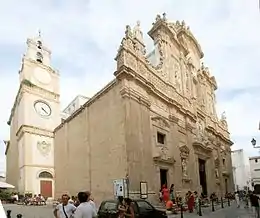Gallipoli Cathedral
The Gallipoli Cathedral, formally the Co-Cathedral Basilica of Saint Agatha the Virgin (Italian: Basilica Concattedrale di Sant'Agata Vergine), is a Roman Catholic church located in the town of Gallipoli in Apulia, Italy. Completed in 1696, the Baroque church is a minor basilica and the co-cathedral of the Diocese of Nardò-Gallipoli.
| Gallipoli Cathedral | |
|---|---|
| Co-Cathedral Basilica of Saint Agatha the Virgin | |
 Front and side of the cathedral | |
| 40°03′17″N 17°58′34″E | |
| Location | Gallipoli, Apulia, Italy |
| Denomination | Roman Catholic |
| Website | www |
| History | |
| Status | Minor basilica, co-cathedral |
| Dedication | Agatha of Sicily |
| Architecture | |
| Architect(s) |
|
| Style | Baroque |
| Groundbreaking | 1629 |
| Completed | 1696 |
| Administration | |
| Diocese | Diocese of Nardò-Gallipoli |
History
The Gallipoli Cathedral was constructed between 1629 and 1696, and is dedicated to Saint Agatha of Sicily.[1]
Architecture
The Baroque facade of the cathedral was designed by Giuseppe Zimbalo,[2] Francesco Bischetini, and Scipione Lachibari. It is constructed out of carparo stone, sourced from Southern Italy.[3] The church was built with a cruciform floorpan in the shape of a Latin cross.[2]
Interior
The interior of the church is a mixture of the Byzantine and Renaissance styles. The nave is flanked by columns of grey marble, which support an arcade.[4] The interior is ornamented by paintings by Giovanni Andrea Coppola, a painter native to Gallipoli.[1] Nicolò Malinconico painted the frescoes on the walls and in the cupola, which depicts the martyrdom of Saint Agatha.[5]
The cathedral's altar is made of a reused Ancient Roman marble stele. There is an Ancient Greek inscription on the stele that reads:[6]
[Δωρ]ον τιμαλφεστατον . . . πελω. / Εγω προσαχ[θεν τη]
τραπεζη τη ξενη / . . . ηπερ ην Μαρζηλιου / [ . . . τριφε]γγους
και τριφω[του . . .]. / Αυθις δε πει[σθεις τη προ]θυμια παση /
Μαγι[. . .]ου πατρωνος αμα και θυτου, / κυρις καθυφιζανεν
ευσεβοφρον(ως) / Παντολεων Προεδρος τουδε του θρονου.
Translated into English:[6]
I am a most precious gift . . . I was placed on the remarkable altar . . . , which belonged
to Marsilios, three times glittering and three times luminous. Acceding to the ardent
desire of Magi . . . os, patron and priest, lord bishop Pantoleon, holder of this throne,
sits with great piety.
See also
References
Citations
- Domenico 2002, p. 27
- "Gallipoli: the Cathedral of St. Agatha Virgin and Martyr of Catania". Foodismo. June 13, 2017. Archived from the original on November 8, 2019. Retrieved November 8, 2019.
- Piuzzi et al. 2018, p. 258
- Briggs 1911, p. 316
- Benigni 1913
- Safran 2014, p. 277
Sources
- Briggs, Martin Shaw (1911). In the Heel of Italy: A Study of an Unknown City. New York: Duffield & Co. OCLC 5247550. Archived from the original on December 19, 2019. Retrieved December 20, 2019 – via Google Books.
- Domenico, Roy (2002). The Regions of Italy: A Reference Guide to History and Culture. Westport, Connecticut: Greenwood Press. ISBN 0-313-30733-4. Archived from the original on December 19, 2019. Retrieved December 19, 2019 – via Google Books.
- Benigni, Umberto (1909). "Diocese of Gallipoli". In Herbermann, Charles (ed.). Catholic Encyclopedia. Vol. 6. New York: Robert Appleton Company.
- Piuzzi, Emanuele; Pittella, Erika; Pisa, Stefano; Cataldo, Andrea; De Benedetto, Egidio; Cannazza, Giuseppe (September 2018). "An improved noninvasive resonance method for water content characterization of Cultural Heritage stone materials". Measurement. 125: 257–261. doi:10.1016/j.measurement.2018.04.070. S2CID 117597277.
- Safran, Linda (2014). "Database: Sites in the Salento with Texts and Images Informative About Identity". The Medieval Salento: Art and Identity in Southern Italy. The Middle Ages Series. Philadelphia: University of Pennsylvania Press. pp. 239–336. ISBN 9780812245547. JSTOR j.ctt5vkcwn.13.